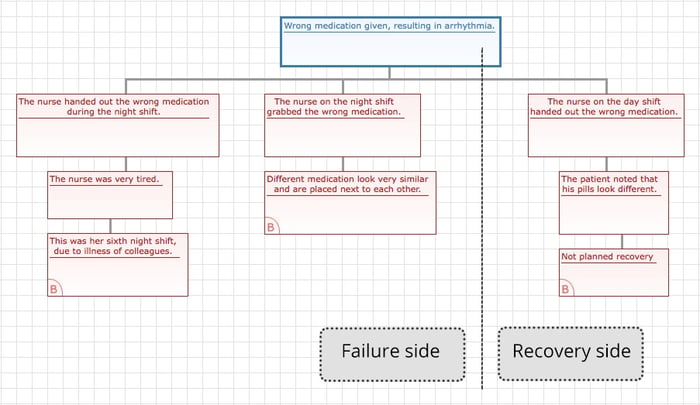Systematic incident analysis and classification is a prerequisite to improving healthcare. There are various methodologies available to achieve this objective. One of these methods is the PRISMA methodology.
This blog describes the characteristics and benefits of incident analysis by using the PRISMA methodology.
Incident analysis
There are various methodologies available to analyse incidents. They can be distinguished from one another in two ways: the system approach and the person approach. The system approach focuses more on the in-built failure mechanism that enables the care professional to make a mistake. The person approach often processes the analysis by registering the incident as attributable to human error.
The most accessible incident analyses target the person approach. This process neither recognises nor classifies the deeper root causes of the origin of the incident: organisational failure factors. The system approach analysis requires a broader examination, because the organisational failure mechanism is less visible than the human failure factors. The results of the analysis are more reliable because all factors are examined that could potentially contribute to an incident coming into being. The PRISMA methodology examines the human, technical and organisational failure factors and is characterised as a system approach. Research shows that the PRISMA methodology is seen as providing added value from the system approach in the process of incident analysis (Habraken, 2005).
"The PRISMA methodology offers a greater chance of finding the root causes of an incident: technical, organisational and human failure factors”.
PRISMA analysis in 3 steps
The PRISMA methodology enables incident analysis in three steps:
- The incident is described in the form of a ‘cause tree’ (see Fig 1 below).
- The root causes, identified by the cause tree, are classified in technical, organisational and human factors.
- A PRISMA profile, consisting of the causes of a large number of incidents, maps the effective improvement measures with the help of a so-called classification/action matrix.
PRISMA stands for Prevention and Recovering Information System for Monitoring and Analysis. The healthcare sector ‘borrowed’ this analysis methodology from the chemical industry, where the method is used to track and trace mistakes and improve processes (a medical version of the Eindhoven Classification Model or ECM).
PRISMA analysis displays incidents in a so-called 'cause tree' (see Fig. 1), so that the events can be demonstrated schematically. The visual display makes the underlying factors and the circumstances at the time clearly legible. Thorough analysis results in effective improvement measures.
“This methodology helped us to understand that there are often more and other root causes for an incident coming into being”.

Figure 1: PRISMA cause tree in TPSC Cloud™ software.
The benefits of PRISMA
Analysis with the help of the PRISMA methodology ensured that we could implement many more improvement measures than previously. An additional advantage is that care professionals felt that they were being listened to with greater attention after the reporting of an incident. The PRISMA methodology made it clear to all that incident reporting was being taken seriously. The issue of who was responsible became less relevant once the deeper underlying causes were revealed. This too had a positive impact on the willingness of care professionals to report incidents. A structured approach to incident reporting generates awareness of the root cause of incidents. This promotes a culture of ‘safety-first’ thinking”.
The root causes of the origin of an incident can be classified in and allocated to the five categories of Professor Van der Schaaf’s Eindhoven Classification Model:
Root causes identified with the help of traditional analysis methodologies:
- 70% human failure
- 10% organisational failure
- 5% patient-related failure
Root causes identified with the help of the PRISMA methodology:
- 40% human failure
- 40% organisational failure
- 2% patient-related failure
- 11% technical failure
- Technical
- Organisational
- Human
- Patient related
- Other
Targeted improvement measures can be implemented on the basis of these failure factors to prevent reoccurrence of these incidents, thereby boosting patient safety.
For a Quality Assurance Officer, it can be interesting to maintain a database with the root causes of regularly-occurring incidents. Important in this respect is that the root causes are reflected in percentages, not in actual statistics. When 30-50 reported incidents have been analysed with the help of the PRISMA methodology, the root causes that ‘peak’ can be identified. These root causes can then be addressed with focused improvement measures. Subsequent PRISMA analysis can make it clear if the unwanted peak has been reduced – and if the improvement measures have worked.
Incident Management eBook
The TPSC CloudTM Incident Manager solution supports incident reporting with the help of a Fishbone Diagram, also known as an Ishikawa analysis. This makes it immediately clear which root causes can be attributed to the origin of an incident.
With the help of an expansive PRISMA or HFMEA methodology, a comprehensive analysis can be undertaken to determine the weaknesses in existing processes. This contributes in turn to the improvement process, whereby risks for patients and staff are reduced while quality increases.
Like to read more about incident analysis? Download our eBook 'Incident Management, In search of continuous healthcare improvement':





